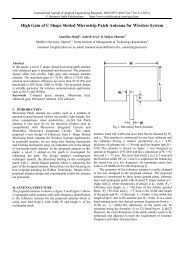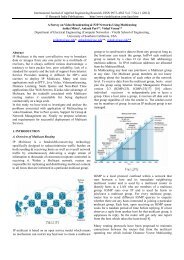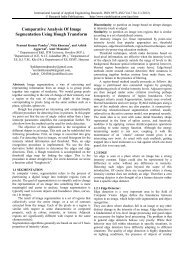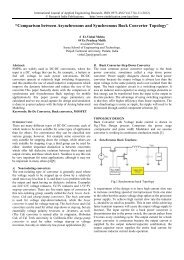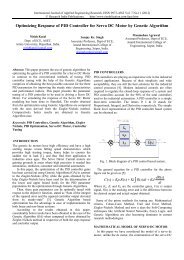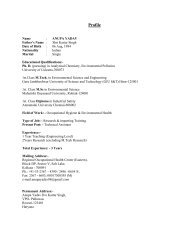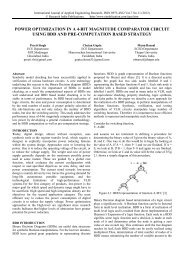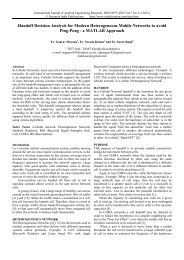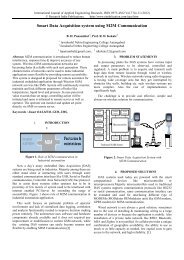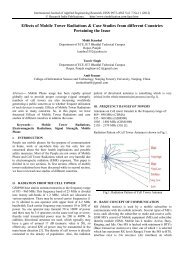Dynamic Bandwidth Allocation among Authentic Mobile Nodes in ...
Dynamic Bandwidth Allocation among Authentic Mobile Nodes in ...
Dynamic Bandwidth Allocation among Authentic Mobile Nodes in ...
You also want an ePaper? Increase the reach of your titles
YUMPU automatically turns print PDFs into web optimized ePapers that Google loves.
International Journal of Applied Eng<strong>in</strong>eer<strong>in</strong>g Research, ISSN 0973-4562 Vol.7 No.11 (2012)© Research India Publications; http://www.ripublication.com/ijaer.htmTABLE-3: Pseudo code of BRM_sig_dis function{ MN_k i :=number of MNs <strong>in</strong> the coverage areaofBS k_iComputes MN_K i from List_BS k_i__Computes MN_BRM k as ∑(MN_K )P_BS k_i :=arrival probability of MNs <strong>in</strong> thecoveragearea of BS k_iComputes P_BS k_i as MN_k i /MN_BRM ktotsig_BS k_i :=total signature assigns to BS k_iComputes totsig_BS k_i asP_BS k_i *totsig_BRM k }2.1.2 Signature assignment technique:BS k_i generates Sig j for New_ MN j <strong>in</strong> the form of (j, BRM k ,BS k_i , t3, Sig_j) and assigns it to New_MN j . The size ofsignature packet (Size_SPAC) islog 2 (tot_MN CAM )+log 2 (tot_BRM)+log 2 (tot_BRM_BS)+(Size_TS)+(Size_Sig_j) bits, where Size_TS is the size of timestampfield and Size_Sig_j is the size of signature. BS k_i <strong>in</strong>serts Sig_j<strong>in</strong> List k_i and sends an authentication message (AM) <strong>in</strong> theform of Sig_j to BRM k . BRM k <strong>in</strong>creases New k by 1, <strong>in</strong>sertsSig_j <strong>in</strong> List_BS k_i and sends an authentication message <strong>in</strong> theform of Sig_j to CAM. CAM <strong>in</strong>serts Sig_j <strong>in</strong> List_BRM k . Thesize of authentication message (Size_AM) is (Size_Sig_j) bits.So the communication overhead of the signature assignmenttechnique (COOH_SA) for New_MN j is(2*Size_AM+Size_SPAC) bits.2.1.3 Signature verification technique:The verification of signature associated with Intra_MN j andInter_MN j is considered for discussion <strong>in</strong> this section.Signature verification for Intra_MN j : Let Sig j is of the form of(j, BRM k , BS k_p , t2, Sig_j). BS k_i detects an <strong>in</strong>tra handoff ofMN j from BS k_p and sends an <strong>in</strong>tra traceability message <strong>in</strong> theform (BS k_p , Sig_j) to BRM k . The size of this <strong>in</strong>tra traceabilitymessage (Size_Intra_TM) is log 2 (tot_BRM_BS)+(Size_Sig_j)bits. BRM k searches List_BS k_p for Sig_j.If not found Intra_MN j is not authentic. BRM k resets aflag and sends <strong>in</strong>tra revocation message <strong>in</strong> the form of (Sig_j,flag) to BS k_i and CAM. CAM <strong>in</strong>serts Sig_j <strong>in</strong> the revocationlist.Otherwise Intra_MN j is authentic. BRM k <strong>in</strong>creases Intra k by1, sets a flag and sends an <strong>in</strong>tra acknowledgement message <strong>in</strong>the form of (Sig_j, flag) to BS k_i . The size of <strong>in</strong>traacknowledgement message (Size_Intra_ACK) is(Size_Sig_j)+1 bits. BRM k also starts to wait for the deletionlist which conta<strong>in</strong>s Sig_j as one of the deleted signatures fromBS k_p under its coverage area. The size of the deletion list(Size_DL) for MN j is Size_Sig_j bits. BRM k <strong>in</strong>serts Sig_j <strong>in</strong>List_BS k_i and deletes Sig_j from List_BS k_p after receiv<strong>in</strong>gthe deletion list from BS k_p . BS k_i <strong>in</strong>serts Sig_j <strong>in</strong> List k_i andassigns the same signature to Intra_MN j by replac<strong>in</strong>g BS k_p byBS k_j and t2 by the current time stamp. BS k_i enters <strong>in</strong>to thesession <strong>in</strong>itiation phase as discussed <strong>in</strong> section 2.2.So the communication overhead of the signatureverification technique for authentic Intra_MN j(COOH_SV <strong>in</strong>tra )is(Size_Intra_TM+Size_Intra_ACK+Size_DL+Size_SPAC)bits.Signature verification for Inter_MN j : Let Sig j is of the form of(j, BRM q , BS q_t , t1, Sig_j). BS k_i detects an <strong>in</strong>ter handoff ofMN j from BRM q to BRM k and sends an <strong>in</strong>ter traceabilitymessage <strong>in</strong> the form of (BRM q , BS q_t , Sig_j) to BRM k . Thesize of this <strong>in</strong>ter traceability message (Size_Inter_TM BS ) islog 2 (tot_BRM)+log 2 (tot_BRM_BS) + (Size_Sig_j) bits. BRM ksends an <strong>in</strong>ter traceability message <strong>in</strong> the form of (BRM q ,Sig_j) to CAM. The size of this <strong>in</strong>ter traceability message(Size_Inter_TM BRM ) is log 2 (tot_BRM)+(Size_Sig_j) bits.CAM searches List_BRM q for Sig_j.If not found, Inter_MN j is not authentic. CAM resets theflag and sends <strong>in</strong>ter revocation message <strong>in</strong> the form of (Sig_j,flag) to BS k_i through BRM k . CAM also <strong>in</strong>serts Sig_j <strong>in</strong> therevocation list.Otherwise Inter_MN j is authentic, CAM sets a flag, sends<strong>in</strong>ter acknowledgement message <strong>in</strong> the form of (Sig_j, flag) toBRM k and also starts to wait for the deletion list whichconta<strong>in</strong>s Sig_j as one of the deleted signatures from BRM qunder its coverage area. CAM <strong>in</strong>serts Sig_j <strong>in</strong> List_BRM k anddeletes Sig_j from List_BRM q after receiv<strong>in</strong>g the deletion listfrom BRM q . BRM k <strong>in</strong>creases Inter k by 1 and sends <strong>in</strong>teracknowledgement message to BS k_i <strong>in</strong> the form of (Sig_j,flag). The size of <strong>in</strong>ter acknowledgement message(Size_Inter_ACK) is identical to Size_Intra_ACK. BRM k<strong>in</strong>serts Sig_j <strong>in</strong> List_BS k_i . BS k_i <strong>in</strong>serts Sig_j <strong>in</strong> List k_i ,assigns the same signature to Inter_MN j by replac<strong>in</strong>g BRM qby BRM k , BS q_t by BS k_i and t1 by the current time stamp.BS k_i enters <strong>in</strong>to the session <strong>in</strong>itiation phase. So thecommunication overhead <strong>in</strong> the signature verification phasefor authentic Inter_MN j (COOH_SV <strong>in</strong>ter ) is(Size_Inter_TM BS +Size_Inter_TM BRM +2*Size_Inter_ACK+Size_DL+Size_SPAC) bits.2.2 Session <strong>in</strong>itiation phase: BS k_i uses this phase to establishthe requested session of MN j after verify<strong>in</strong>g its authentication.The pseudo code of this phase of operation is shown <strong>in</strong>TABLE-4.TABLE-4: Pseudo code of session <strong>in</strong>itiation phase{ MN j sends new session request message to BS k_ifor p thclass of traffic//Functions of BS k_iComputes the desired bandwidth to establish thesessionof MN jExecutes session establishment function forcheck<strong>in</strong>g theavailability of desired bandwidthIf desired bandwidth is available{Sends positive acknowledgement to MN jExecutes bandwidth reservation functionUpdates details of ongo<strong>in</strong>g sessions of MN j <strong>in</strong>TABLE-5Computes bandwidth utilizationSends bandwidth utilization to BRM kGo to L}Else
International Journal of Applied Eng<strong>in</strong>eer<strong>in</strong>g Research, ISSN 0973-4562 Vol.7 No.11 (2012)© Research India Publications; http://www.ripublication.com/ijaer.htm{Sends negative acknowledgement to MN jExecutes bandwidth reservation functionComputes the number of block<strong>in</strong>g sessions ofMN jUpdates TABLE-5Go to L}}L: Starts to process the session <strong>in</strong> TABLE-5 us<strong>in</strong>gprocess<strong>in</strong>g new session function2.2.1 <strong>Bandwidth</strong> reservation function: BS k_i ma<strong>in</strong>ta<strong>in</strong>s 3counters to count the number of new session requests pertraffic class. The counter C k_i_p is used to count the number ofnew session requests for p th class of traffic. BS k_i <strong>in</strong>creasesC k_i_p by 1 when it receives a new session request message forp th class of traffic from MN j . It also computes the total numberof new session request (tot_n k_i ) asC __ and arrivalprobability of p th class of new session request (AP k_i_p ) asC k_i_p /(tot_n k_i ).Let the available bandwidth at BS k_i is BW k_i kbps which isassigned by BRM k as discussed <strong>in</strong> section 2.2.4. BS k_i reservesa fraction of BW k_i for new session request per traffic classdynamically depend<strong>in</strong>g upon their arrival probability. So thereserved bandwidth for p th class of new session request (R k_i_p )is AP k+i_p *BW k _ i kbps. It also computes its total unusedbandwidth as (BW k_i -R __ ) kbps and ma<strong>in</strong>ta<strong>in</strong>s thisbandwidth <strong>in</strong> a bandwidth reservation pool (BR_Pool k_i ).2.2.2 Details of ongo<strong>in</strong>g sessions:BS k_i ma<strong>in</strong>ta<strong>in</strong>s a list of ongo<strong>in</strong>g sessions with<strong>in</strong> its coveragearea <strong>in</strong> tabular form as shown <strong>in</strong> TABLE-5. Each row <strong>in</strong>TABLE-5 has a few records and it is for a particular MNwhich is identified by MN_id attribute of the records. Thenumber of row <strong>in</strong> TABLE-5 depends up on the number ofMNs with<strong>in</strong> the coverage area of BS k_i (MN_k i ). The numberof records <strong>in</strong> the row of a particular MN_id depends upon thenumber of different types of traffic classes for which thecorrespond<strong>in</strong>g MN_id has ongo<strong>in</strong>g sessions. For example, j1 thMN (MN j1 ) has ongo<strong>in</strong>g sessions for all the 3 classes of trafficwhereas j2 th MN (MN j2 ) has ongo<strong>in</strong>g sessions for class 1 andclass 3 type of traffic as observed from TABLE-5. B j1 and B j2are the total number of block<strong>in</strong>g sessions of MN j1 and MN j2respectively.TABLE-5: List of ongo<strong>in</strong>g sessionsMN_id TrafficclassMN j1 123MN j2 13Number ofpacket pertraffic classP 1j1P 2j1P 3j1P 1j2P 3j2Totalnumber ofblock<strong>in</strong>gsessionUpdation of TABLE-5: Let BS k_i receives a new sessionrequest message from MN j for class 3 type of traffic <strong>in</strong> theform of (j, 3, NO_OF_PAC j ). BS k_i uses session establishmentB j1B j2function as discussed <strong>in</strong> section 2.2.3 to verify the availabilityof the desired bandwidth (=RC 3 *NO_OF_PAC j ) for thetransmission of NO_OF_PAC j number of class 3 type ofpackets. BS k_i searches TABLE-5 for MN j . If not found it<strong>in</strong>serts a new row <strong>in</strong> TABLE-5 for MN j . In the new row thevalue of the MN_id attribute is <strong>in</strong>serted as MN j , traffic classattribute is <strong>in</strong>serted 3, number of packets per traffic classattribute is <strong>in</strong>serted as NO_OF_PAC j if the desired bandwidthis available otherwise 0 and total number of block<strong>in</strong>g sessionattribute is <strong>in</strong>serted as 0 if the desired bandwidth is availableotherwise 1. Otherwise BS k_i searches the exist<strong>in</strong>g records ofMN j <strong>in</strong> TABLE-5 for class 3 type of traffic. If found BS k_i<strong>in</strong>creases the number of packet per traffic class attribute byNO_OF_PAC j if the desired bandwidth is available and totalnumber of block<strong>in</strong>g session attribute by 1 if the desiredbandwidth is not available. Otherwise BS k_i <strong>in</strong>serts a newrecord <strong>in</strong> the exist<strong>in</strong>g row of MN j <strong>in</strong> TABLE-5. In the newrecord the value of the traffic class attribute is <strong>in</strong>serted as 3,number of packet per traffic class attribute is <strong>in</strong>serted asNO_OF_PAC j if the desired bandwidth is available otherwise0 and total number of block<strong>in</strong>g session attribute is <strong>in</strong>serted as0 if the desired bandwidth is available otherwise 1. BS k_ideletes a row from TABLE-5 if the MN correspond<strong>in</strong>g to thatrow goes out from the coverage area of BS k_i . It deletes arecord from a particular row of TABLE-5 if the ongo<strong>in</strong>gsession correspond<strong>in</strong>g to that record is over.Computation of unused bandwidth:BS k_i consults with TABLE-5 and computes the used reservebandwidth for class 1 (UR k_i_1 ), class 2 (UR k_i_2 ) and class 3(UR k_i_3 ) type of new session request as RC 1 *(P 1j1 +P 1j2 ) kbps,RC 2 *P 2j1 kbps and RC 3 *(P 3j1 +P 3j2 ) kbps respectively. It alsocomputes the unused bandwidth for new session request of p thclass of traffic (UU k_i_p ) as (R k_i_p -UR k_i_p ), where UR k_i_p bethe used reserve bandwidth for p th class of traffic.Computation of bandwidth utilization:It computes the bandwidth utilization (BU k_i )as UR __ / R __ . It sends BU k_i to BRM k .Each BRM receives bandwidth utilization from all thetot_BRM_BS number of BSs under its coverage areaperiodically. Let the bandwidth available at N k is B k . So BRM kallocates a fraction of B k as__(BW k_i =(BU k_i / BU _ )*B k ) to BS k_i under it. Itrepeats the same operation for all the tot_BRM_BS number ofBSs under its coverage area.Computation of user satisfaction:BS k_i computes the block<strong>in</strong>g probability (BP) of MN j1 (BP j1 )and MN j2 (BP j2 ) as B j1 /(P 1j1 +P 2j1 +P 3j1 ) and B j2 /(P 1j2 +P 3j2 )respectively. It also computes user satisfaction (US) of MN j1(US j1 ) and MN j2 (US j2 ) as 1 - BP j1 and 1 - BP j2 respectively.2.2.3 Session establishment function:BS k_i uses this function to verify the availability of the desiredbandwidth after receiv<strong>in</strong>g any new session request messagefrom a MN which is authentic. If BS k_i receives a new sessionrequest message for class 1 type of traffic from MN j , it
International Journal of Applied Eng<strong>in</strong>eer<strong>in</strong>g Research, ISSN 0973-4562 Vol.7 No.11 (2012)© Research India Publications; http://www.ripublication.com/ijaer.htmcomputes the desired bandwidth (D 1 ) as the product of RC 1and the number of packets <strong>in</strong> the requested session. BS k_iestablishes the session if UU k_i_1 >D 1 else if BR_Pool k_i >D 1else if UU k_i_3 >D 1 else if UU k_i_2 >D 1 else block the session. IfBS k_i receives a new session request message for class 2 typeof traffic from MN j , it computes the desired bandwidth (D 2 ) asthe product of RC 2 and the number of packets <strong>in</strong> the requestedsession. BS k_i establishes the session if UU k_i_2 >D 2 else ifBR_Pool k_i >D 2 else if UU k_i_3 >D 2 else block the session. IfBS k_i receives a new session request message for class 3 typeof traffic from MN j , it computes the desired bandwidth (D 3 ) asthe product of RC 3 and the number of packets <strong>in</strong> the requestedsession. BS k_i establishes the session if UU k_i_3 >D 3 else ifBR_Pool k_i >D 3 else block the session. In case of block ofsession BS k_i <strong>in</strong>creases a block count counter (Block_Count k_i )by 1.2.2.4 Process<strong>in</strong>g new session function:BS k_i computes the user satisfaction of the MNs that enters<strong>in</strong>to its coverage area and arranges their user satisfaction <strong>in</strong> theascend<strong>in</strong>g order <strong>in</strong> a list. Let MN j1 and MN j2 are the two MNs<strong>in</strong> the coverage area of BS k_i hav<strong>in</strong>g user satisfaction US j1 andUS j2 respectively and they have ongo<strong>in</strong>g sessions as shown <strong>in</strong>TABLE-5. If US j1
International Journal of Applied Eng<strong>in</strong>eer<strong>in</strong>g Research, ISSN 0973-4562 Vol.7 No.11 (2012)© Research India Publications; http://www.ripublication.com/ijaer.htmFig.3 <strong>Bandwidth</strong> utilization vs. Traffic loadAt low traffic load both the average session loss and averagebandwidth utilization are m<strong>in</strong>imum as most of the bandwidthat all the 3 networks are free. At heavy traffic load all the 3networks are saturated. So at heavy traffic load the averagesession loss <strong>in</strong>creases but the average bandwidth utilizationbecomes almost constant as most of the bandwidth at all the 3networks is utilized. It can be observed from Fig.2 and Fig.3that the average session loss is m<strong>in</strong>imum and averagebandwidth utilization is maximum for WiMAX network dueto its high data rate whereas average session loss is maximumand average bandwidth utilization is m<strong>in</strong>imum for GPRSnetwork due to its low data rate. The data rate of IEEE 802.11network is higher than GPRS network and lower thanWiMAX network. So its performance <strong>in</strong> terms of session lossand bandwidth utilization is better than GPRS network andworse than WiMAX network.IV.CONCLUSIONThe present work is a dynamic bandwidth allocation scheme<strong>among</strong> MNs <strong>in</strong> heterogeneous networks. It considers the<strong>in</strong>tegration of 3 access networks. The available bandwidth ateach access network is distributed dynamically <strong>among</strong> theMNs for establish<strong>in</strong>g their sessions. The proposed work can beextended by consider<strong>in</strong>g the QoS factor normalization and theoverall architecture implementation.REFERENCES[1] C.Perk<strong>in</strong>s, “IP Mobility Support for IPv4”, IETFRFC 3344, August 2002.[2] D.Johnson, C.Perk<strong>in</strong>s, and J.Arkko, “MobilitySupport <strong>in</strong> IPv6”, IETF RFC 3775, June 2004.[3] C.Ahlund, R.Brannstrom, K.Andersson andO.Tjernstrom, “Port-based Multihomed <strong>Mobile</strong> IPv6for Heterogeneous Networks”, Local ComputerNetworks, pp.567-568, November 2006.[4] E.Nordmark and M.Bagnulo, “Shim6: Level 3Multihom<strong>in</strong>g Shim Protocol for IPv6”, Internet-Draft,draft-ietf-shim6-proto-10.txt, February 2008.[5] R.Atk<strong>in</strong>son, S.Bhatti and S.Hailes, “A proposal forunify<strong>in</strong>g mobility with multi-hom<strong>in</strong>g, NAT, andsecurity”, pp. 74-83, MobiWac ACM 2007.[6] http://en.wikipedia.org/wiki/Key_generation



